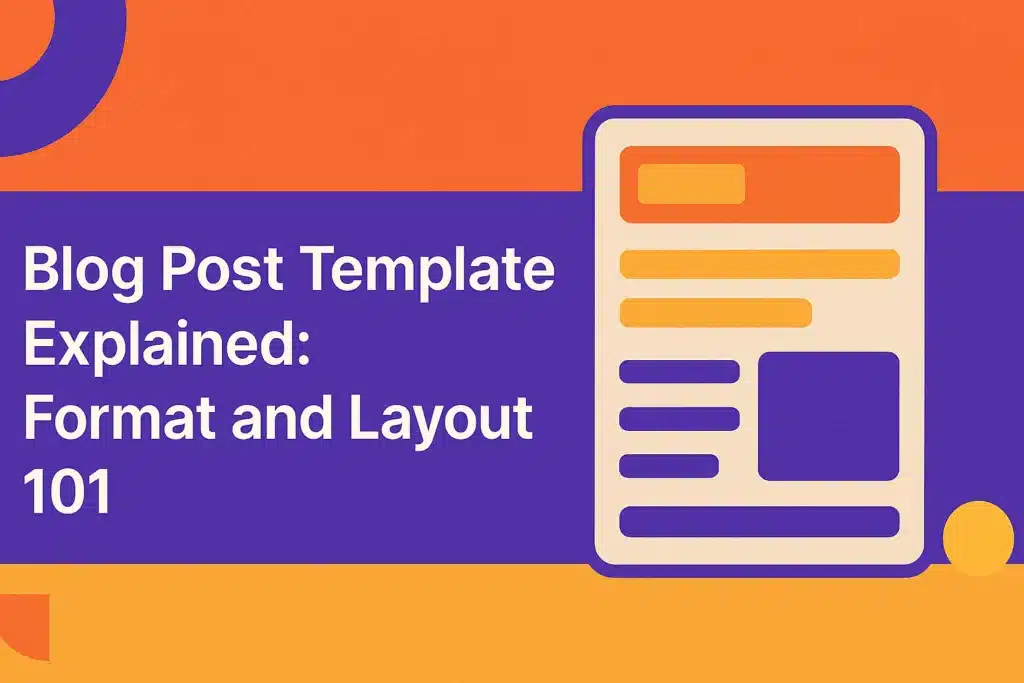Readers often look for an organized layout and supportive direction. An organized template provides that sense of order by breaking content into defined steps, which saves time on planning. It also helps making sure that no key point slips off the radar. By doing so, every element—from headline to CTA—works together smoothly, giving your audience a more rewarding time.
In today’s crowded digital space, readers have endless choices. They often move toward blogs that provide clear insights and smooth structure. A tidy layout makes it simpler to move through sections and find crucial points. By applying a consistent structure each time you create content, you deliver both familiarity and value. Below, you will find the basic principles and practical tips required to shape a valuable, reader-friendly resource.
What is a Blog Post Template?
A blog post template is a well-defined outline that guides you through the entire writing process. It formally arranges elements like headline, intro, body, and conclusion into a trusted layout. You can adapt it to different subjects or industries. This method saves hours of guesswork and ensures you stay focused, delivering helpful content to your audience with minimal fuss.
Essential Elements in a Blog Writing Format
Every blog writing format shares basic elements that shape each reader’s journey. An interesting headline grabs attention, while a clear intro explains the topic. The body shows main points, and a conclusion brings everything together. Finally, a strong call-to-action invites further involvement. When combined, these elements establish structure and keep your content targeted. Readers benefit from a logical flow.
Headline that gets attention
A catchy headline hooks potential visitors. It hints at your subject and sparks curiosity, prompting them to click. Top bloggers often pick concise, descriptive titles that promise an important takeaway. This method sets the initial tone and encourages further review of the main content.
Introduction that hooks the reader
An interesting intro interests new visitors by announcing your central idea. It sets the context so they know what to expect without feeling swamped. Use a provocative question or a clear statement. The central goal is to encourage quick interest and promise a meaningful read.
Body that delivers clear value
Your main section should address your audience’s most pressing questions. According to Forbes, Google no longer fixates on rigid keyword density but instead focuses on relevant context ([Forbes](https://www.forbes.com/sites/allbusiness/2018/04/20/the-8-essential-elements-of-a-successful-blog-post/)). Focus on straightforward points, practical examples, and pertinent details so readers gain fuller grasp as they read.
Conclusion that wraps up the message
A concluding section restates the key insights without adding entirely new details. A concise summary reminds readers why your tips still matter today and motivates them to reflect on what they have learned. You can then guide them toward related topics or actions.
Call-to-action for next steps
Effective calls-to-action steer readers in a specific direction. According to WordStream, well-placed CTAs can boost clicks by up to 80% [WordStream]. Start with a strong verb, add a clear incentive, and deploy urgency to drive action. This strategy helps turn casual readers into subscribers or leads and can convert them over time.
How to Structure Your Blog Content Template
A consistent blog content template sets the guidelines for arranging key sections. You can assign headings to represent main ideas, insert subheadings for clarity, and provide bullet points or short paragraphs. This setup breaks complex concepts into simple pieces. It also improves overall clarity, keeps messages unified, and encourages ongoing readership.
Follow a logical information flow
Readers value a clear path. According to Feather, people typically spend around 37 seconds on an article, so it’s best to direct them naturally from one point to the next [Feather]. Group related ideas, start with a strong opener, and transition smoothly. This approach prevents confusion and retains their attention.
Use of headings, subheadings, and bullet points
Break paragraphs up with headings and subheadings so readers can scan quickly. Content Powered notes that every blog needs a single H1 for the title and multiple H2 tags to highlight main sections [Content Powered]. Bullet points help visitors find key takeaways and stay engaged. This practice also improves clarity.
Keep tone, voice, and formatting consistent
Keeping a coherent style across posts builds credibility. Microsoft’s guidelines encourage a clear voice that still feels friendly [DK Consulting of Colorado]. Set a style guide covering grammar, preferred vocabulary, and overall tone. This step helps your readers recognize your brand wherever they see your content.
Match content with user search intent
Matching blog posts with search intent improves exposure. As Backlinko’s research shows, 92% of SEO professionals cite matching format to search intent as essential [Single Grain]. First, determine if reader queries are informational, navigational, commercial, or transactional. Then tailor your headings and details to match those needs for better results.
Different Blog Layout Ideas to Consider
Various blog layout ideas can change how readers see your content. Certain formats favor concise tips, while others fit thorough, in-depth posts. You can choose a layout that best suits your business objectives and writing style. Some may prefer step-by-step tutorials, while others enjoy comparisons. By exploring multiple shapes of content, you offer variety, improving audience engagement and building consistent traffic.
Listicle layout for step-by-step readability
Listicles break down info into numbered sections, which helps readers skim. BuzzSumo discovered that numerous top viral articles use this structure [Omniscient Digital]. Each part addresses a single main topic, helping visitors locate details quickly. This format also works well for tips, how-tos, or selected lists.
How-to layout for instructional posts
A how-to layout focuses on guiding readers from challenges to solutions. According to RyRob, inserting images can raise content views by 94% [RyRob.com]. Each segment has concise paragraphs, clarifying the steps required. This approach appeals to beginners seeking direct instructions they can follow straight away.
Storytelling layout for personal or narrative blogs
Storytelling formats revolve around personal time or narrative arcs. RyRob shows that placing images can increase reader interest up to 65%. Writers share anecdotes or timelines to engage emotions. This method often connects with audiences who enjoy a more relatable journey.
Answer-first layout for SEO-oriented format
An answer-first structure targets quick responses, which can help your content appear in featured snippets. RyRob notes that 3% of bloggers who use multiple images see stronger performance. Provide the direct answer first before expanding on details. This technique can improve user happiness and search engine positioning.
Practical Blog Post Examples to Guide You
Real-world samples offer direction as you refine your approach. Each example displays a distinct style, from timelines to product reviews. By reviewing existing content, you can discover new angles that better match your objectives. Always choose examples that suit your topic’s depth; it helps you produce precise, reader-aligned writing and keeps everything consistent.
News-style post with updates
News-style content lets you share current events or hot updates. HypeGig suggests announcing developments with clarity and credible sources ([HypeGig](https://hypegig.com/blog-post-examples/)). This format suits stories about product launches or sudden industry shifts. Keep it straightforward so readers quickly grasp the main points.
Review-based blog post structure
In a review-based piece, you examine specific products or services. WPBeginner notes that there are over 600 million blogs, so standing out requires both detail and honesty [WPBeginner]. Thoroughly cover pros, cons, and user viewpoint. Add images or live demos. Readers often seek clear insights that guide their decisions, which still matters greatly now.
Thought leadership article layout
Thought leadership articles aim to present fresh perspectives or new ideas. They often include personal expertise or original data. The goal is to spark conversation and highlight authority. By addressing modern challenges, writers build credibility and offer viable solutions. Readers typically respect thorough and well-researched arguments.
Round-up or list-based blog template
Round-up posts gather several opinions or resources in one thorough guide. Backlinko demonstrates that list-based formats can drive big traffic. Each section features its own idea or tip, letting audiences compare options quickly. Remember to highlight key points, reference sources properly, and keep it neatly arranged.
Conclusion
Making a go-to blog post template involves picking the right structure, clarifying your message, and delivering tangible benefits for your readers. By steadily following a chosen outline, they know precisely where to find your main thoughts and how to keep track of them. Whether you favor listicle, narrative, or product-focused layouts, remain focused on utility and order. Each component carries its own purpose, and pairing tight flow with clear formatting can improve both engagement and loyalty. Testing various formats uncovers what connects most with your readers. Over time, you refine and adapt your approach to simplify their reading time, showing that you truly honor their time. In the end, this strategy builds trust and creates fruitful connections.
FAQs
What is the best blog post template for beginners?
How do I choose the right blog writing format for my audience?
Can a blog post template improve SEO performance?
Is there a blog content template I can reuse easily?
What blog layout ideas work best for content marketing?

Ridam Khare is an SEO strategist with 7+ years of experience specializing in AI-driven content creation. He helps businesses scale high-quality blogs that rank, engage, and convert.



